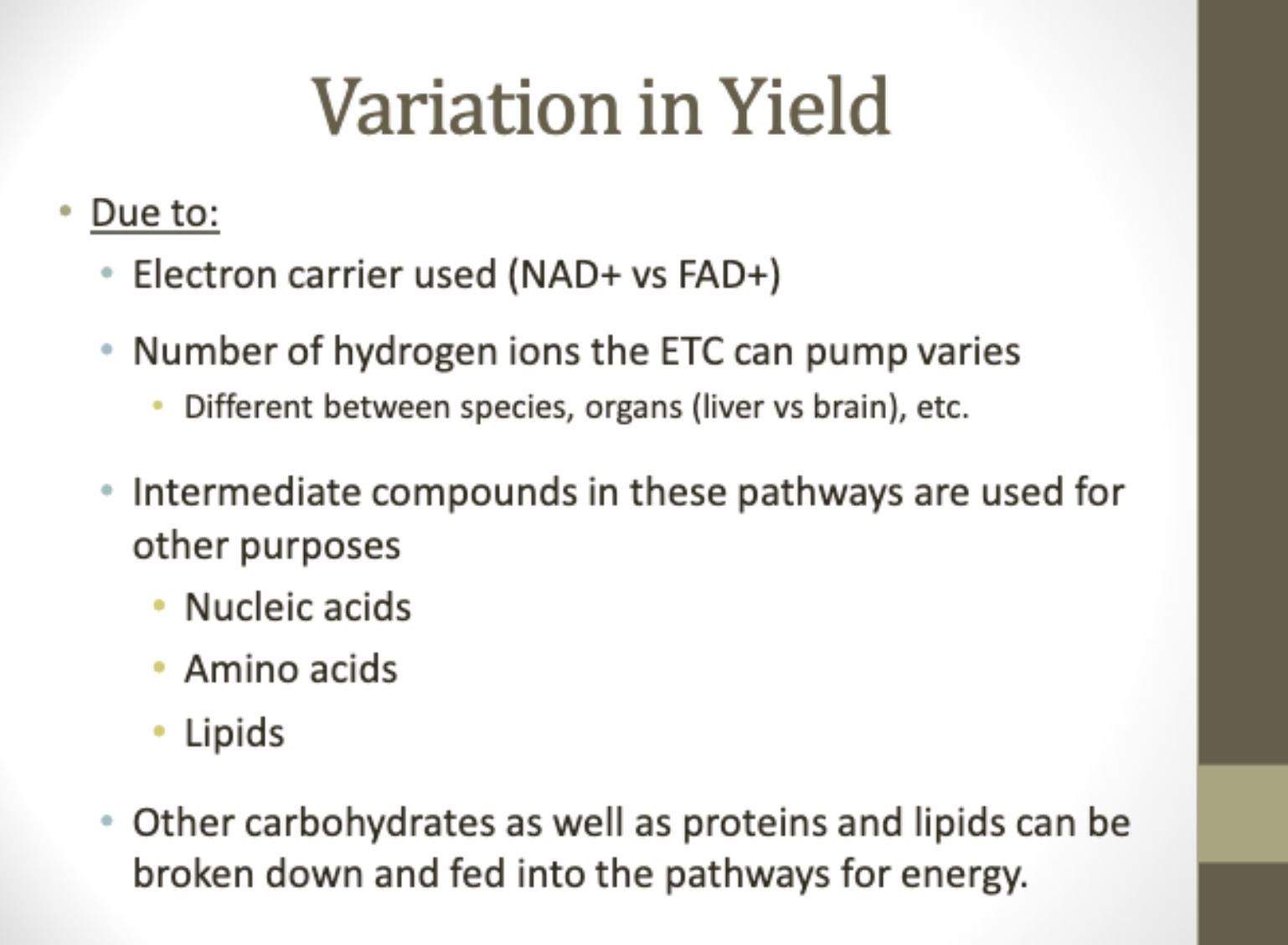Biology exam 106 chapter 7
1/36
There's no tags or description
Looks like no tags are added yet.
Name | Mastery | Learn | Test | Matching | Spaced |
|---|
No study sessions yet.
37 Terms
Cellular respiration
producers and consumers are able to extract the energy from the bonds in glucose and convert it into a form that all living things can use ATP, this series of metabolic reactions
oxidation reactions
strip an electron from an atom in a compound
reduction reaction
add the electron to another compound
chemiosmosis
when ions move by diffusion across a semi permeable membrane
aerobic
oxygen required
anaerobic
oxygen not required
fermentation
processes that use an organic molecule to regenerate NAD+ from NADH
Redox reaction
Oxidation and reduction reactions occur together
The series of reactions that producers and consumers use to extract energy from the bonds of sugar molecules is called?
Cellular respiration
How does the cell harness/transfer energy through redox reactions?
by using electron carriers to move electrons like oxidative and reduction reactions
What are electron carriers? Name two examples.
some compounds readily accepting and donating electrons (NADH, FAD2)
What is NAD? What is its oxidized/reduced form?
Nicotinamide adenine dinucleotide (NAD+, Reduced NADH)
What is FAD? What is its oxidized/reduced form?
Flavin adenine dinucleotide (FAD+/FADH2)
reducing agent
a compound that reduces another compound
oxidizing agent
a compound that oxidizes another compound
What are the four major steps of cellular respiration?
glycolysis, citric acid cycle, oxidation of pyruvate, electron transport chain
Which of the four steps require oxygen? Which do not?
glycolysis citric acid cycle, oxidation of pyruvate, electron transport chain, dont: glycolysis and fermentation
What is the purpose of the reduction and subsequent oxidation of all the electron
carrier molecules?
facilitate the transfer of electrons and energy
What happens to reduction and subsequent oxidation after they have served their purpose?
they are recycled and used again
What is the energy from the redox reactions in the electron transport chain used to
do?
pump protons across a membrane
Chemiosmosis energy transfer and ions involved
Complexes I, III, IV transport hydrogen ions (H+) across the inner mitochondrial membrane from the matrix, into the inter membrane space
Where does the chemiosmotic gradient occur in eukaryotic cells?
inner mitochondrial membrane
How do the protons move back across the membrane?
ATP synthesis
Oxidative phosphoralation products
38 ATP per glucose, on average 30-32 ATP
How is the energy transferred to ATP?
synthesizing it from ADP and inorganic products
What is the theoretical energetic yield of cellular respiration?
38 ATP
What is a more realistic estimate of energy yield?
30-32
Why is there such variation in the amount of energy actually made?

How are carbohydrates other than glucose, proteins, and lipids used as sources of
energy?
Carbohydrates are stored as glycogen and broken down
to glucose to enter glycolysis
What is the limiting factor in performing cellular respiration in the absence of
oxygen?
The inability to complete the electron transport chain and oxidative phosphorylation
How is glycolysis able to work around this limitation?
through fermentation pathways, also doesn’t need oxygen to continue on
Alchol fermentation
Pyruvate is enzymatically converted to a 2-carbon molecule called
acetaldehyde.
Also produces ethanol to help make bread. They release Carbon dioxide
Lactic Acid fermentation
Our muscle cells use lactic acid fermentation when oxygen supply
is depleted. The enzyme lactate dehydrogenase (LDH) converts pyruvate into
lactate, and in doing so, NADH is oxidized back to NAD+
How is NADH oxidized in each of the two types of fermentation?
Lactic Acid- converts pyruvate into lactate, and in doing so, NADH is oxidized back to NAD+
Alcohol Fermentation-Acetaldehyde serves as an electron acceptor for NADH, forming the NAD+ required.
List two reasons why cellular respiration should be regulated.
to maintain energy balance and to use intermediate molecules for other pathways
Give two specific examples of feedback inhibition on the rate of cellular respiration.
The enzyme phosphofructokinase is the main enzyme controlled in glycolysis. High levels of ATP or product (citrate) decrease this enzymes activity and slow glycolysis.
The rate of electron transport through the ETC pathway is slowed by high levels of ATP, and sped up by high levels of ADP.
Give specific examples of how cellular respiration regulated
By proteins which transport glucose into the cell
By the number and specificity of the glycolysis, oxidation,
fermentation, citric acid cycle, etc. enzymes.
By the presence of coenzymes, cofactors, competitive &
allosteric inhibitors